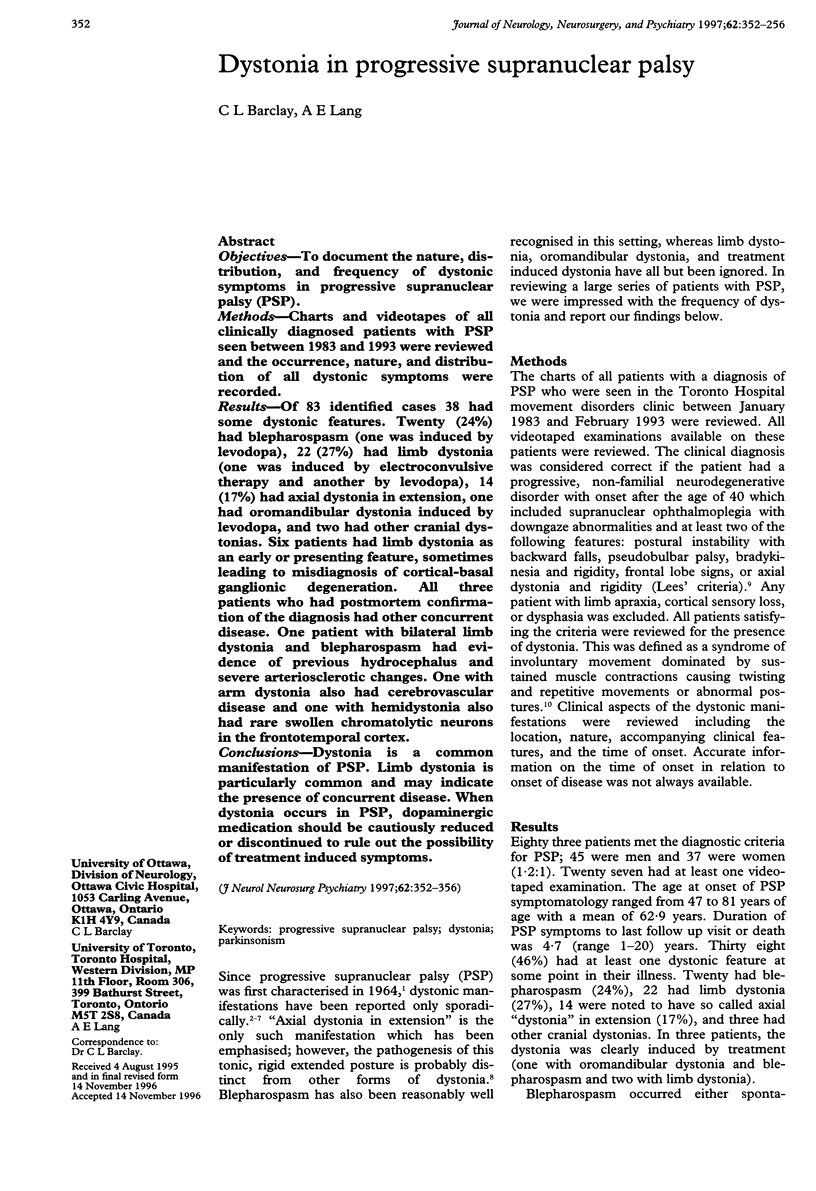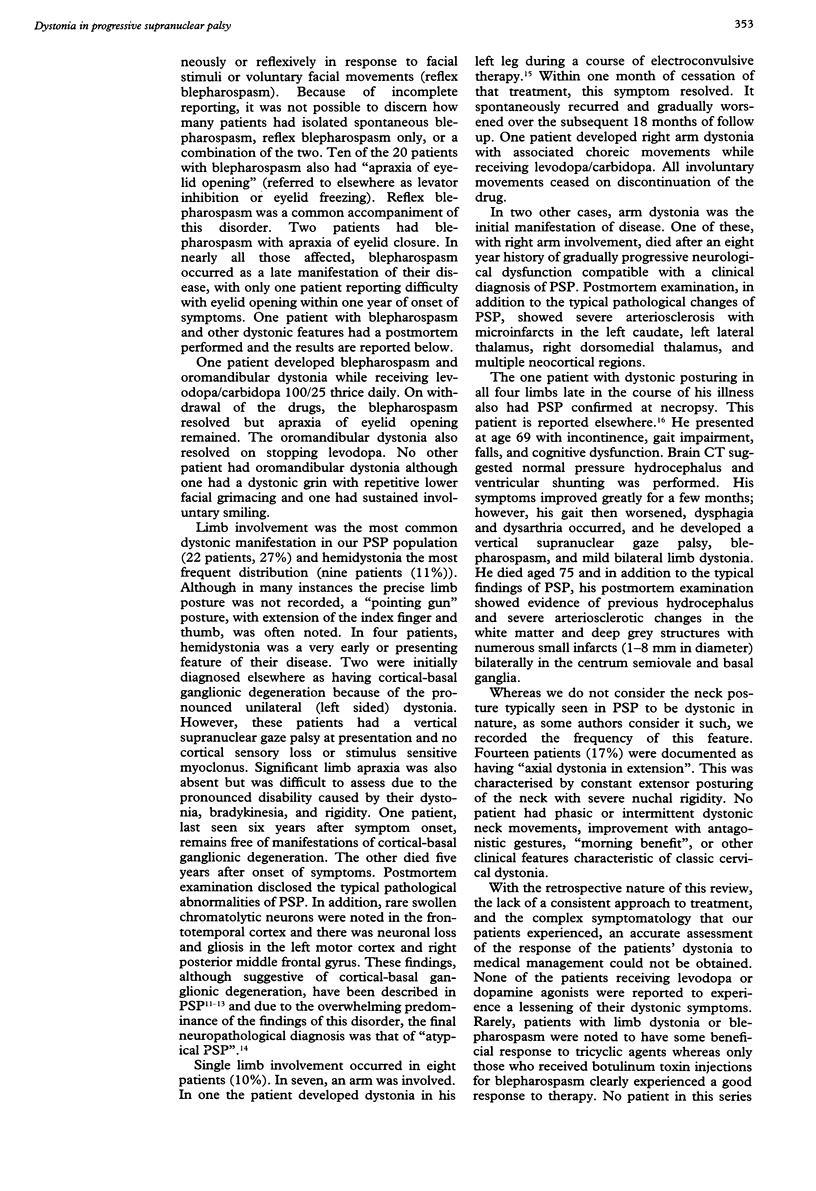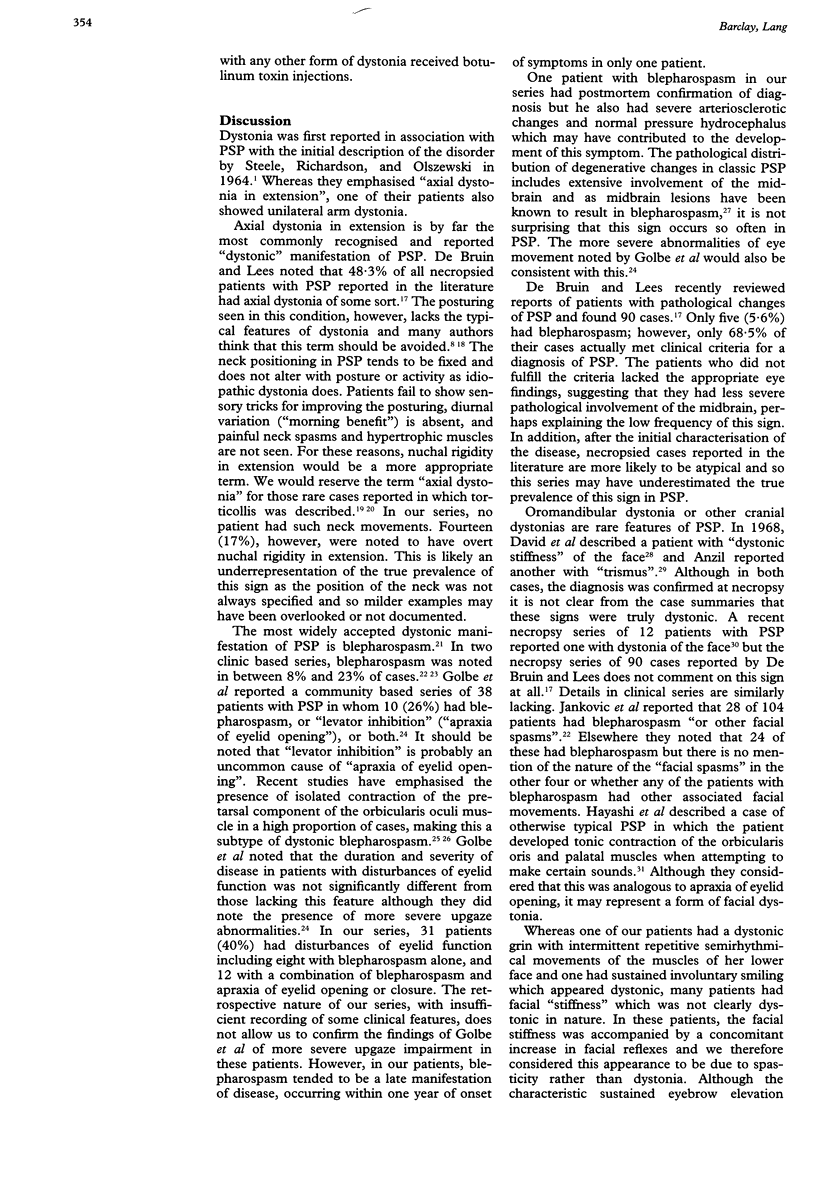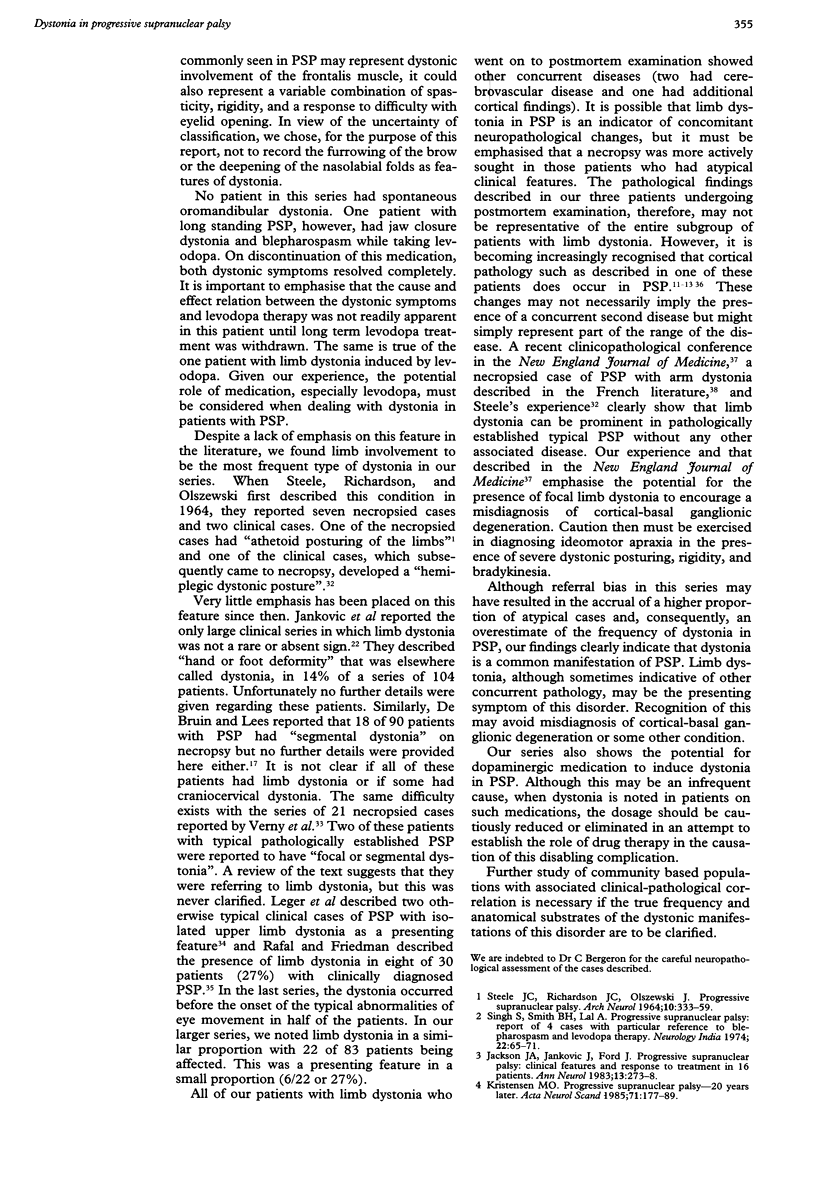Abstract
OBJECTIVES: To document the nature, distribution, and frequency of dystonic symptoms in progressive supranuclear palsy (PSP). METHODS: Charts and videotapes of all clinically diagnosed patients with PSP seen between 1983 and 1993 were reviewed and the occurrence, nature, and distribution of all dystonic symptoms were recorded. RESULTS: Of 83 identified cases 38 had some dystonic features. Twenty (24%) had blepharospasm (one was induced by levodopa), 22 (27%) had limb dystonia (one was induced by electroconvulsive therapy and another by levodopa), 14 (17%) had axial dystonia in extension, one had oromandibular dystonia induced by levodopa, and two had other cranial dystonias. Six patients had limb dystonia as an early or presenting feature, sometimes leading to misdiagnosis of cortical-basal ganglionic degeneration. All three patients who had postmortem confirmation of the diagnosis had other concurrent disease. One patient with bilateral limb dystonia and blepharospasm had evidence of previous hydrocephalus and severe arteriosclerotic changes. One with arm dystonia also had cerebrovascular disease and one with hemidystonia also had rare swollen chromatolytic neurons in the frontotemporal cortex. CONCLUSIONS: Dystonia is a common manifestation of PSP. Limb dystonia is particularly common and may indicate the presence of concurrent disease. When dystonia occurs in PSP, dopaminergic medication should be cautiously reduced or discontinued to rule out the possibility of treatment induced symptoms.
Full text
PDF




Selected References
These references are in PubMed. This may not be the complete list of references from this article.
- Anzil A. P. Progressive supranuclear palsy. Case report with pathological findings. Acta Neuropathol. 1969 Sep 9;14(1):72–76. doi: 10.1007/BF00687704. [DOI] [PubMed] [Google Scholar]
- Aramideh M., Ongerboer de Visser B. W., Koelman J. H., Bour L. J., Devriese P. P., Speelman J. D. Clinical and electromyographic features of levator palpebrae superioris muscle dysfunction in involuntary eyelid closure. Mov Disord. 1994 Jul;9(4):395–402. doi: 10.1002/mds.870090404. [DOI] [PubMed] [Google Scholar]
- Brick J. F., Gutmann L., Brick J., Apelgren K. N., Riggs J. E. Timber rattlesnake venom-induced myokymia: evidence for peripheral nerve origin. Neurology. 1987 Sep;37(9):1545–1546. doi: 10.1212/wnl.37.9.1545. [DOI] [PubMed] [Google Scholar]
- Collins S. J., Ahlskog J. E., Parisi J. E., Maraganore D. M. Progressive supranuclear palsy: neuropathologically based diagnostic clinical criteria. J Neurol Neurosurg Psychiatry. 1995 Feb;58(2):167–173. doi: 10.1136/jnnp.58.2.167. [DOI] [PMC free article] [PubMed] [Google Scholar]
- Constantinidis J., Tissot R., de Ajuriaguerra J. Dystonie oculo-facio-cervicale ou paralysie progressive supranucléaire de Steele-Richardson-Olszewski. Pseudo-paralysie du regard, troubles visuo-spatiaux, pseudo-démence, altérations neuronales. Rev Neurol (Paris) 1970 Apr;122(4):249–262. [PubMed] [Google Scholar]
- Curran T., Lang A. E. Parkinsonian syndromes associated with hydrocephalus: case reports, a review of the literature, and pathophysiological hypotheses. Mov Disord. 1994 Sep;9(5):508–520. doi: 10.1002/mds.870090503. [DOI] [PubMed] [Google Scholar]
- David N. J., Mackey E. A., Smith J. L. Further observations in progressive supranuclear palsy. Neurology. 1968 Apr;18(4):349–356. doi: 10.1212/wnl.18.4.349. [DOI] [PubMed] [Google Scholar]
- De Bruin V. M., Lees A. J. Subcortical neurofibrillary degeneration presenting as Steele-Richardson-Olszewski and other related syndromes: a review of 90 pathologically verified cases. Mov Disord. 1994 Jul;9(4):381–389. doi: 10.1002/mds.870090402. [DOI] [PubMed] [Google Scholar]
- Duvoisin R. C., Golbe L. I., Lepore F. E. Progressive supranuclear palsy. Can J Neurol Sci. 1987 Aug;14(3 Suppl):547–554. [PubMed] [Google Scholar]
- Fukushima-Kudo J., Fukushima K., Tashiro K. Rigidity and dorsiflexion of the neck in progressive supranuclear palsy and the interstitial nucleus of Cajal. J Neurol Neurosurg Psychiatry. 1987 Sep;50(9):1197–1203. doi: 10.1136/jnnp.50.9.1197. [DOI] [PMC free article] [PubMed] [Google Scholar]
- Fénelon G., Guillard A., Romatet S., Feve A., Mahieux F. Les signes parkinsoniens du syndrome de Steele-Richardson-Olszewski. Rev Neurol (Paris) 1993;149(1):30–36. [PubMed] [Google Scholar]
- Giaccone G., Tagliavini F., Street J. S., Ghetti B., Bugiani O. Progressive supranuclear palsy with hypertrophy of the olives. An immunocytochemical study of the cytoskeleton of argyrophilic neurons. Acta Neuropathol. 1988;77(1):14–20. doi: 10.1007/BF00688237. [DOI] [PubMed] [Google Scholar]
- Golbe L. I., Davis P. H., Lepore F. E. Eyelid movement abnormalities in progressive supranuclear palsy. Mov Disord. 1989;4(4):297–302. doi: 10.1002/mds.870040402. [DOI] [PubMed] [Google Scholar]
- Hayashi M., Isozaki E., Suga M., Horiguchi S., Hayashida T. [A case of progressive supranuclear palsy presenting mouth opening difficulty with tonic contraction of the orbicularis oris muscle]. Rinsho Shinkeigaku. 1992 Nov;32(11):1250–1255. [PubMed] [Google Scholar]
- Jackson J. A., Jankovic J., Ford J. Progressive supranuclear palsy: clinical features and response to treatment in 16 patients. Ann Neurol. 1983 Mar;13(3):273–278. doi: 10.1002/ana.410130308. [DOI] [PubMed] [Google Scholar]
- Jankovic J., Friedman D. I., Pirozzolo F. J., McCrary J. A. Progressive supranuclear palsy: motor, neurobehavioral, and neuro-ophthalmic findings. Adv Neurol. 1990;53:293–304. [PubMed] [Google Scholar]
- Jankovic J., Patel S. C. Blepharospasm associated with brainstem lesions. Neurology. 1983 Sep;33(9):1237–1240. doi: 10.1212/wnl.33.9.1237. [DOI] [PubMed] [Google Scholar]
- Khunadorn N., Kalumpaheti R., Saipetara K. Blepharospasm in progressive supranuclear palsy: the first case in Thailand. J Med Assoc Thai. 1979 Feb;62(2):89–92. [PubMed] [Google Scholar]
- Krack P., Marion M. H. "Apraxia of lid opening," a focal eyelid dystonia: clinical study of 32 patients. Mov Disord. 1994 Nov;9(6):610–615. doi: 10.1002/mds.870090605. [DOI] [PubMed] [Google Scholar]
- Kristensen M. O. Progressive supranuclear palsy--20 years later. Acta Neurol Scand. 1985 Mar;71(3):177–189. doi: 10.1111/j.1600-0404.1985.tb03186.x. [DOI] [PubMed] [Google Scholar]
- Lantos P. L. The neuropathology of progressive supranuclear palsy. J Neural Transm Suppl. 1994;42:137–152. doi: 10.1007/978-3-7091-6641-3_11. [DOI] [PubMed] [Google Scholar]
- Léger J. M., Girault J. A., Bolgert F. Deux cas de dystonie isolée d'un membre supérieur inaugurant une maladie de Steele-Richardson-Olszewski. Rev Neurol (Paris) 1987;143(2):140–142. [PubMed] [Google Scholar]
- Maher E. R., Lees A. J. The clinical features and natural history of the Steele-Richardson-Olszewski syndrome (progressive supranuclear palsy). Neurology. 1986 Jul;36(7):1005–1008. doi: 10.1212/wnl.36.7.1005. [DOI] [PubMed] [Google Scholar]
- Nishimura T., Ikeda K., Akiyama H., Kondo H., Kato M., Li F., Iseki E., Kosaka K. Immunohistochemical investigation of tau-positive structures in the cerebral cortex of patients with progressive supranuclear palsy. Neurosci Lett. 1995 Dec 8;201(2):123–126. doi: 10.1016/0304-3940(95)12151-x. [DOI] [PubMed] [Google Scholar]
- Paulus W., Selim M. Corticonigral degeneration with neuronal achromasia and basal neurofibrillary tangles. Acta Neuropathol. 1990;81(1):89–94. doi: 10.1007/BF00662643. [DOI] [PubMed] [Google Scholar]
- Pfaffenbach D. D., Layton D. D., Jr, Kearns T. P. Ocular manifestations in progressive supranuclear palsy. Am J Ophthalmol. 1972 Dec;74(6):1179–1184. doi: 10.1016/0002-9394(72)90740-4. [DOI] [PubMed] [Google Scholar]
- Rivest J., Quinn N., Marsden C. D. Dystonia in Parkinson's disease, multiple system atrophy, and progressive supranuclear palsy. Neurology. 1990 Oct;40(10):1571–1578. doi: 10.1212/wnl.40.10.1571. [DOI] [PubMed] [Google Scholar]
- STEELE J. C., RICHARDSON J. C., OLSZEWSKI J. PROGRESSIVE SUPRANUCLEAR PALSY. A HETEROGENEOUS DEGENERATION INVOLVING THE BRAIN STEM, BASAL GANGLIA AND CEREBELLUM WITH VERTICAL GAZE AND PSEUDOBULBAR PALSY, NUCHAL DYSTONIA AND DEMENTIA. Arch Neurol. 1964 Apr;10:333–359. doi: 10.1001/archneur.1964.00460160003001. [DOI] [PubMed] [Google Scholar]
- Singh S., Smith B. H., Lal A. Progressive supranuclear palsy (report of 4 cases with particular reference to blepharospasm and levodopa therapy). Neurol India. 1974 Jun;22(2):65–71. [PubMed] [Google Scholar]
- Steele J. C. Progressive supranuclear palsy. Brain. 1972;95(4):693–704. [PubMed] [Google Scholar]
- Vermersch P., Robitaille Y., Bernier L., Wattez A., Gauvreau D., Delacourte A. Biochemical mapping of neurofibrillary degeneration in a case of progressive supranuclear palsy: evidence for general cortical involvement. Acta Neuropathol. 1994;87(6):572–577. doi: 10.1007/BF00293317. [DOI] [PubMed] [Google Scholar]
- Verny M., Jellinger K. A., Hauw J. J., Bancher C., Litvan I., Agid Y. Progressive supranuclear palsy: a clinicopathological study of 21 cases. Acta Neuropathol. 1996;91(4):427–431. doi: 10.1007/s004010050446. [DOI] [PubMed] [Google Scholar]
- Weinmann R. L. Heterogeneous system degeneration of the central nervous system associated with peripheral neuropathy. Neurology. 1967 Jun;17(6):597–603. doi: 10.1212/wnl.17.6.597. [DOI] [PubMed] [Google Scholar]


